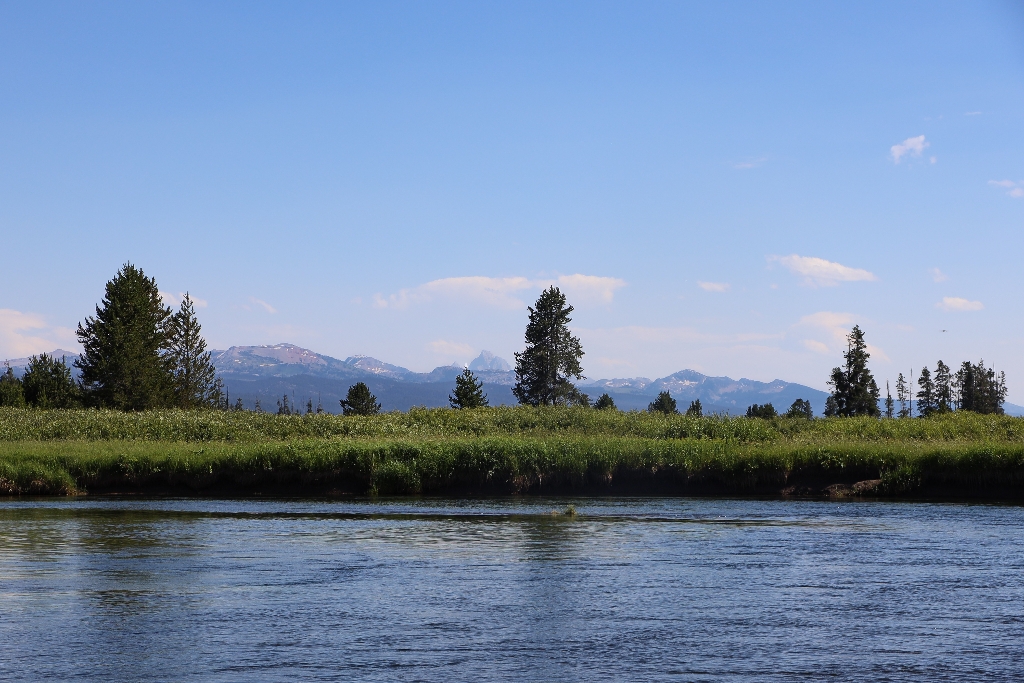
This trailhead is located along the Cave Falls Road, just north of the southern park boundary. This trailhead provides access to the following trails:
- Boundary Creek
- Bechler River Cutoff Trail
- Bechler River Trail
- South Boundary Trail: Bechler Ranger Station–Grassy Lake
- Robinson Creek Trail
Boundary Creek Trail
A moderate 17.2-mile (27.7-km) one-way trail that travels across relative flat lands, through forests and meadows, and past several waterfalls around the middle sections of the trail. The northern end of the trail starts on the western boundary of the park, while the southern end starts near the Bechler Ranger Station.
Bechler River Cutoff Trail
An easy 1.6-mile (2.6-km) one-way trail that connects between the Bechler Ranger Station and the Bechler River Trail.
Bechler River Trail
A classic, strenuous roughly 30-mile (48-km) one-way backpacking trail in the southwest part of the park that leads past waterfalls and hydrothermal features. The trail starts at either the Bechler Ranger Station or at Lone Star Geyser.
South Boundary Trail: Bechler Ranger Station–Grassy Lake
This difficult 7.6-mile (12.2-km) one-way trail is mainly an administrative trail that goes between the Bechler Ranger Station in the west and the Fish Lake-Mountain
Ash Cutoff Trail to the east. The fording of Fall River near the Cave Falls Trailhead is wide and dangerous, and not recommended.
Robinson Creek Trail
An easy 9.1-mile (14.6-km) one-way trail that leads to Robinson Lake (about 2.2 miles/ 3.5 km from the southern end of the trail).
Backcountry Regulations
Permit required for fishing, boating, riding, and overnight camping. More information at the Center Backcountry Office: (307) 344-2160.
Hiking
Hike in groups of 3 or more; keep your group together. Tell someone where you are going and when you expect to return. Know your route, carry a map, and be able to navigate. Do not hike after dark. Stay on established trails; off-trail travel prohibited in thermal areas.
Fishing and Boating
Aquatic Invasive Species (AIS) inspection required for all watercraft including boats, float tubes, and stand up paddle boards. Felt soles prohibited.
Riding and Packing
Proof of negative Coggins test within last 12 months required.
Food Storage and Camping
These regulations apply to ALL backcountry users. Sleep 100 yards (91 m) from your food storage and cooking areas. Do not leave food, trash, toiletries, backpacks, coolers, water bottles, or any potential attractant unattended. Store food in an approved bear resistant container or hang on a food pole 10 feet (3 m) above the ground and 4 feet (1 m) from sides. Carry a minimum of 35 feet (11 m) of rope. Campfires allowed only in designated campsites within established fire rings. Extinguish campfires completely before leaving site.
Follow LEAVE NO TRACE travel and camping techniques. Enjoy the backcountry and help keep it clean for others to enjoy. Bury human waste and toilet tissue in a 6–8 inch (15–18 cm) deep “cat hole” at least 100 feet (30 m) from water and trails.
River Crossings
Park waters are swift and cold. Swimming in park rivers is not recommended. River crossings are hazardous.
Lightning Safety
During thunderstorms, descend to lower elevation, avoid open areas and isolated tall trees. Assume lightning position: feet together, crouch on foam pad or sit on pack, hands over ears.
Regulations
- Leave What You Find: Do not collect anything from the park.
- No Pets: No pets on trail. Obtain service animal regulations at backcountry offices.
- No Hunting: No hunting or discharge of firearms.
- No Motorized Vehicles: No motorized vehicles on trails.
- Wheeled Vehicles Restricted: No bicycles, strollers, or wheeled vehicles (except wheelchairs), except where specified.
In an emergency, dial 9-1-1 or contact the nearest ranger station.
Animals are Dangerous
- Do not approach or feed any animal.
- Bison and elk have injured people.
- Stay 100 yards (91 m) from bears and wolves.
- Stay 25 yards (23 m) from all other animals.
Be Prepared for a Bear Encounter
Grizzly and black bears inhabit all of Yellowstone National Park.
Be Alert: Watch for signs of bear activity: scratches in trees, tracks, scat, or dig sites. Avoid dead animals.
Make Noise: Avoid surprising a bear by calling out and clapping your hands at regular intervals to make your presence known.
Carry Bear Spray: Carry bear spray and know how to use it. Keep it immediately available, not inside your pack.
Hike in Groups: Travel in groups of 3 or more is recommended. Stay with your group at all times.
What to do...
If You Encounter a Bear: Stay calm, do not run. Quietly detour or back away; stop if this seems to agitate the bear. Stay at least 100 yards (91 m) from bears. Do NOT feed bears or other animals.
If a Bear Charges You: Stand still, do not run. Stand your ground and use your bear spray. Spray when the bear is 60 feet (18 m) away or closer. If a bear charges, it may be a bluff charge.
If a Bear Makes Contact: Drop to the ground; play dead. Lie face down and clasp your hands over the back of your neck; stay still and silent. Wait several minutes after the bear leaves before getting up and leaving the area.
Is there something we missed for this itinerary?
Itineraries across USA


















































